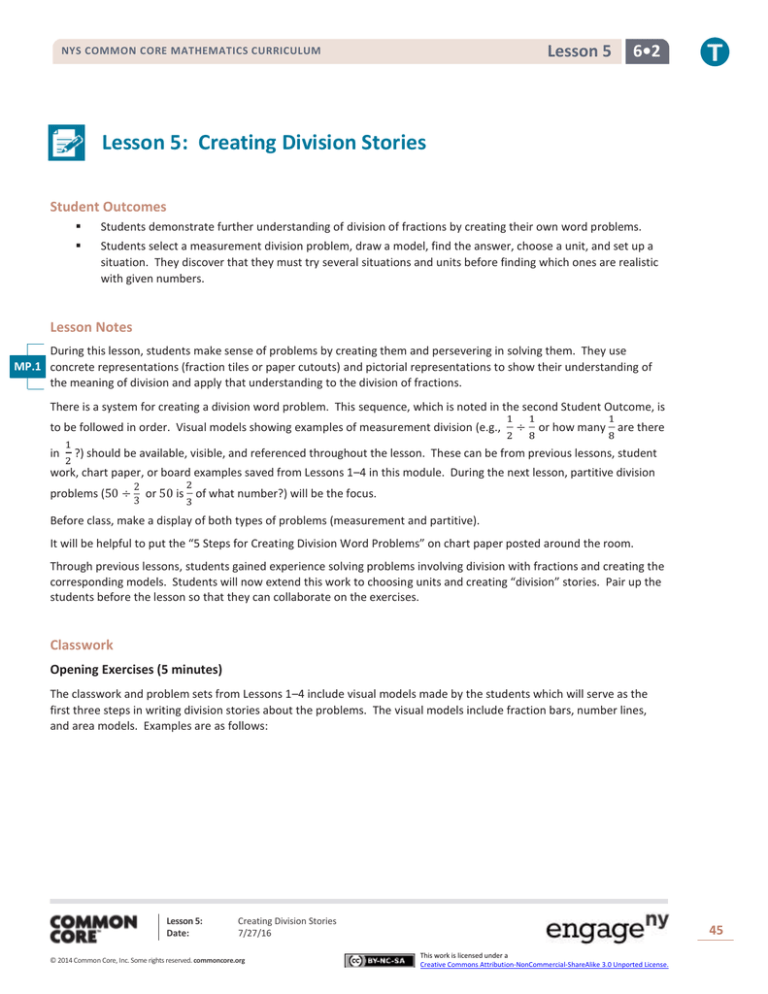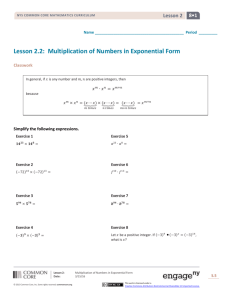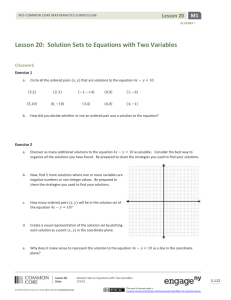Lesson 5: Creating Division Stories 6•2 Lesson 5
advertisement

Lesson 5 NYS COMMON CORE MATHEMATICS CURRICULUM 6•2 Lesson 5: Creating Division Stories Student Outcomes Students demonstrate further understanding of division of fractions by creating their own word problems. Students select a measurement division problem, draw a model, find the answer, choose a unit, and set up a situation. They discover that they must try several situations and units before finding which ones are realistic with given numbers. Lesson Notes During this lesson, students make sense of problems by creating them and persevering in solving them. They use MP.1 concrete representations (fraction tiles or paper cutouts) and pictorial representations to show their understanding of the meaning of division and apply that understanding to the division of fractions. There is a system for creating a division word problem. This sequence, which is noted in the second Student Outcome, is to be followed in order. Visual models showing examples of measurement division (e.g., in 1 2 1 2 ÷ 1 8 1 or how many are there 8 ?) should be available, visible, and referenced throughout the lesson. These can be from previous lessons, student work, chart paper, or board examples saved from Lessons 1–4 in this module. During the next lesson, partitive division problems (50 ÷ 2 2 or 50 is of what number?) will be the focus. 3 3 Before class, make a display of both types of problems (measurement and partitive). It will be helpful to put the “5 Steps for Creating Division Word Problems” on chart paper posted around the room. Through previous lessons, students gained experience solving problems involving division with fractions and creating the corresponding models. Students will now extend this work to choosing units and creating “division” stories. Pair up the students before the lesson so that they can collaborate on the exercises. Classwork Opening Exercises (5 minutes) The classwork and problem sets from Lessons 1–4 include visual models made by the students which will serve as the first three steps in writing division stories about the problems. The visual models include fraction bars, number lines, and area models. Examples are as follows: Lesson 5: Date: Creating Division Stories 7/27/16 © 2014 Common Core, Inc. Some rights reserved. commoncore.org 45 This work is licensed under a Creative Commons Attribution-NonCommercial-ShareAlike 3.0 Unported License. Lesson 5 NYS COMMON CORE MATHEMATICS CURRICULUM 6•2 Opening Exercises Fraction Bar: 𝟖 𝟗 ÷ 𝟐 𝟖 𝟗 𝟗 𝟐 𝟗 𝟐 𝟗 𝟐 𝟗 𝟐 𝟗 𝟐 Here we have 𝟒 groups of . Therefore, the answer is 𝟒. 𝟗 Number Line: Xavier, Molly’s friend, purchased 𝟏𝟏 𝟖 cups of strawberries. If he eats 𝟑 𝟒 of a cup of strawberries per serving, how many servings will he have? 𝟓 𝟔 𝟏 𝟏 𝟖 𝟎 𝟐 𝟖 He will have 𝟏 and 𝟓 𝟔 𝟑 𝟖 𝟒 𝟖 𝟓 𝟖 𝟔 𝟖 𝟕 𝟖 𝟖 𝟖 𝟗 𝟖 𝟏𝟎 𝟖 𝟏𝟏 𝟖 𝟏𝟐 𝟖 servings. Area Model: 𝟑 𝟓 ÷ 𝟏 𝟒 This can be rewritten as 𝟏 𝟏𝟐 𝟐𝟎 ÷ 𝟓 𝟐𝟎 + = 𝟏𝟐 𝟓 𝟐 =𝟐 . 𝟓 𝟏 + 2 5 Use a few minutes to review the problem set from the last lesson. Ask students to add another model to each answer. Lesson 5: Date: Creating Division Stories 7/27/16 © 2014 Common Core, Inc. Some rights reserved. commoncore.org 46 This work is licensed under a Creative Commons Attribution-NonCommercial-ShareAlike 3.0 Unported License. Lesson 5 NYS COMMON CORE MATHEMATICS CURRICULUM 6•2 Discussion (5 minutes) When we know the original amount and the size or measure of one part, we use measurement division to find the number of parts. You can tell when a question is asking for measurement division because it asks, “How many _____ are in _________?” Writing division stories involves five steps that are to be done in order. The steps are as follows: (1) decide on an interpretation (measurement or partitive); (2) draw a model; (3) find the answer; (4) choose a unit; and (5) set up a situation. Today, we will work only on measurement division problems, and tomorrow, we will work on partitive division problems. By looking at all the work we have posted around the room, which of these steps are already done? Steps 1, 2, and 3 are already done. Today, we will also focus on extending our work involving division with fractions to choosing units and setting up a story situation. Example 1 (10 minutes) MP.2 In this example, students reason abstractly and quantitatively. They make sense of quantities and their relationships in problems and understand “how many” as it pertains to the divisor when finding the quotients of fractions. Encourage students to work each step in order. 1 1 1 1 8 8 2 Let’s look at an example of measurement division: Our first step in writing a story problem is to decide which division interpretation to use. Do we need to decide this, or is it already given in this problem? 2 ÷ or how many are there in ? Example 1 𝟏 𝟏 ÷ 𝟐 𝟖 Step 1: Decide on an interpretation. The interpretation, measurement division, is given in this problem. Our second step is to sketch out a model. This should be done neatly and fairly accurately, but should not take too long to do. Use a tape diagram or fraction bar to model this problem on your paper. Scaffolding: Step 2: Draw a model. Note: This drawing can be cut and pasted onto an interactive whiteboard document and then labeled. Lesson 5: Date: Plastic fraction tile sets should be available for students who prefer a concrete model to handle. These are also useful for students who have difficulty making accurate sketches to show their work. Creating Division Stories 7/27/16 © 2014 Common Core, Inc. Some rights reserved. commoncore.org 47 This work is licensed under a Creative Commons Attribution-NonCommercial-ShareAlike 3.0 Unported License. 𝟏 𝟖 𝟏 𝟐 𝟏 𝟖 𝟏 𝟖 6•2 Lesson 5 NYS COMMON CORE MATHEMATICS CURRICULUM 𝟏 𝟐 𝟏 𝟖 The third step is to find the answer to the problem. Do this on your paper. Step 3: Find the answer. 𝟏 𝟏 𝟒 𝟏 𝟒 ÷ = ÷ = =𝟒 𝟐 𝟖 𝟖 𝟖 𝟏 𝟏 𝟏 𝟖 𝟐 So, the answer is 𝟒. There are four in . Step 4: Choose a unit. Answers will vary, but pounds will be used throughout the discussion below. Step 5: Set up a situation. Answers will vary, but there is a story problem provided in the discussion. Now that we have the answer, we can move on to the fourth step, choosing a unit. For measurement division, both divisor and dividend must be the same unit. Note: Choosing the unit and using it in both the divisor and dividend consistently preserves the story situation clearly and precisely. With enough repetition, students will learn to interpret and write division story problems more clearly. 1 1 8 2 Let’s use pounds for this example. We are asking how many pounds are in pound. Step 5 is to set up a situation. This means writing a story problem that includes all of the information necessary to solve it and that is also interesting, realistic, short, and clear. It may take several attempts before you find a story that works well with the given dividend and divisor. One story problem that might go well with these numbers is the following: Bonnie Baker has a total of 1 1 2 pound of chocolate. She needs pound of chocolate for each batch of brownies she bakes. How many 8 1 batches of brownies can Bonnie bake with pound of chocolate? 2 Exercise 1 (5 minutes) Allow students to work with a partner to create the story problem. Also, take time to share and discuss their work. Lesson 5: Date: Creating Division Stories 7/27/16 © 2014 Common Core, Inc. Some rights reserved. commoncore.org 48 This work is licensed under a Creative Commons Attribution-NonCommercial-ShareAlike 3.0 Unported License. Lesson 5 NYS COMMON CORE MATHEMATICS CURRICULUM 6•2 Exercise 1 Using the same dividend and divisor, work with a partner to create your own story problem. You may use the same unit, but your situation must be unique. You could try another unit such as ounces, yards, or miles if you prefer. Possible story problems: 𝟏 1. Tina uses oz. of cinnamon each time she makes a batch of coffee cake topping. How many batches can she make if 𝟏 𝟖 she has oz. left in her spice jar? 𝟐 2. 𝟏 𝟏 𝟐 𝟖 Eugenia has yard of ribbon. For each party decoration, she needs yard. How many party decorations can she make? Example 2 (7 minutes) 3 1 1 3 Let’s look at another example of measurement division: Our first step in writing a story problem is to decide which division interpretation to use. Do we need to decide this, or is it already given in this problem? 4 ÷ 2 or how many 2 are there in ? 4 It is already given in this problem. Example 2 𝟑 𝟏 ÷ 𝟒 𝟐 Step 1: Decide on an interpretation. The interpretation, measurement division, is given in this problem. Our second step is to sketch out a model. This should be done neatly and fairly accurately, but should not take too long to do. Use a tape diagram to model this problem on your paper. Step 2: Draw a diagram. 𝟏 𝟒 𝟏 𝟐 𝟏 𝟒 𝟏 𝟏 𝟒 + 𝟏 𝟐 Step 3: Find the answer. 𝟑 𝟏 𝟑 𝟐 𝟑 𝟏 ÷ = ÷ = =𝟏 . 𝟒 𝟐 𝟒 𝟒 𝟐 𝟐 So, the answer is 𝟏 𝟐 𝟏 𝟐 𝟑 . There are 𝟏 halves in . Lesson 5: Date: 𝟒 Creating Division Stories 7/27/16 © 2014 Common Core, Inc. Some rights reserved. commoncore.org 49 This work is licensed under a Creative Commons Attribution-NonCommercial-ShareAlike 3.0 Unported License. Lesson 5 NYS COMMON CORE MATHEMATICS CURRICULUM 6•2 Step 4: Choose a unit. Answers will vary, but ounces will be used throughout the discussion below. Step 5: Set up a situation. Answers will vary, but there is a story problem provided in the discussion. Step 4 is to choose a unit. Let’s choose ounces. Step 5 is to set up a situation. This means writing a story problem that includes all of the information necessary to solve it and that is also interesting, realistic, short, and clear. It may take several attempts before you find a story that works well with the given dividend and divisor. One story problem that might go well with these numbers is the following: Tia has oz. of coffee left in her 3 4 1 coffee can. She needs oz. to make one cup of coffee. How many cups of coffee can she make? 2 Exercise 2 (5 minutes) Allow students to work with a partner to create the story problem. Also, take time to share and discuss their work. Exercise 2 Using the same dividend and divisor, work with a partner to create your own story problem. You may use the same unit, but your situation must be unique. You could try another unit such as cups, yards, or miles if you prefer. Possible story problems: 𝟏 1. Tiffany uses cup of glycerin each time she makes a batch of soap bubble mixture. How many batches can she make 𝟑 𝟐 if she has cup left in her glycerin bottle? 𝟒 2. 𝟑 𝟏 𝟒 𝟐 Theresa has yard of fabric. For each doll skirt she makes, she needs yard. Does she have enough fabric to make two doll skirts? Closing (5 minutes) How did we extend our work with division with fractions in this lesson? We took an answer to a measurement division problem, added a unit, and then wrote a realistic story that fit the numbers and the unit. What were your biggest challenges when writing story problems involving division with fractions? Accept all answers. Lesson 5: Date: Creating Division Stories 7/27/16 © 2014 Common Core, Inc. Some rights reserved. commoncore.org 50 This work is licensed under a Creative Commons Attribution-NonCommercial-ShareAlike 3.0 Unported License. NYS COMMON CORE MATHEMATICS CURRICULUM Lesson 5 6•2 Lesson Summary The method of creating division stories includes five steps: Step 1: Decide on an interpretation (measurement or partitive). Today we used measurement division. Step 2: Draw a model. Step 3: Find the answer. Step 4: Choose a unit. Step 5: Set up a situation. This means writing a story problem that is interesting, realistic, and short. It may take several attempts before you find a story that works well with the given dividend and divisor. Exit Ticket (3 minutes) Lesson 5: Date: Creating Division Stories 7/27/16 © 2014 Common Core, Inc. Some rights reserved. commoncore.org 51 This work is licensed under a Creative Commons Attribution-NonCommercial-ShareAlike 3.0 Unported License. Lesson 5 NYS COMMON CORE MATHEMATICS CURRICULUM Name ___________________________________________________ 6•2 Date____________________ Lesson 5: Creating Division Stories Exit Ticket Write a story problem for the following measurement division: 3 4 ÷ 1 8 = 6. 1 1 4 1 8 1 4 1 8 Lesson 5: Date: 1 8 1 4 1 8 1 8 1 8 Creating Division Stories 7/27/16 © 2014 Common Core, Inc. Some rights reserved. commoncore.org 52 This work is licensed under a Creative Commons Attribution-NonCommercial-ShareAlike 3.0 Unported License. Lesson 5 NYS COMMON CORE MATHEMATICS CURRICULUM 6•2 Exit Ticket Sample Solution Write a story problem for the following measurement division: 𝟑 𝟒 ÷ 𝟏 𝟖 = 𝟔. 𝟏 𝟏 𝟒 𝟏 𝟒 𝟏 𝟖 𝟏 𝟖 𝟏 𝟒 𝟏 𝟖 𝟏 𝟖 𝟏 𝟖 𝟑 𝟏 𝟒 𝟖 𝟑 𝟏 ÷ = 𝟔.) 𝟒 𝟖 𝟏 𝟖 Arthur divided of his kingdom into parcels of land, each being of the entire kingdom. How many parcels did he make? (Accept any other reasonable story problem showing Problem Set Sample Solutions Please use each of the five steps of the process you learned. Label each step. 1. 𝟑 𝟒 Write a measurement division story problem for 𝟔 ÷ . Step 1: Measurement Step 2: Model, shown below (Students may have used a different type of model.) 𝟏 𝟐 𝟑 𝟒 𝟓 𝟔 𝟑 𝟑 𝟑 𝟑 𝟑 𝟑 𝟑 𝟑 𝟒 𝟒 𝟒 𝟒 𝟒 𝟒 𝟒 𝟒 Step 3: How many 𝟔÷ 𝟑 𝟒 are there in 𝟔? 𝟑 𝟐𝟒 𝟑 𝟐𝟒 = ÷ = =𝟖 𝟒 𝟒 𝟒 𝟑 Step 4: Feet (Answers may vary.) Step 5: Answers may vary, but this is one possible answer. 𝟑 Rafael has a 𝟔-foot piece of wood. He has to cut shelves that are foot long. How many shelves can he cut from 𝟒 the 𝟔-foot board? Lesson 5: Date: Creating Division Stories 7/27/16 © 2014 Common Core, Inc. Some rights reserved. commoncore.org 53 This work is licensed under a Creative Commons Attribution-NonCommercial-ShareAlike 3.0 Unported License. Lesson 5 NYS COMMON CORE MATHEMATICS CURRICULUM 2. Write a measurement division story problem for 𝟓 𝟏𝟐 ÷ 𝟏 𝟔 6•2 . Step 1: Measurement Step 2: Model, shown below (Students may have used a different type of model.) X X X X 𝟏 𝟏 𝟔 𝟔 X 𝟏 𝟔 𝟏 𝟓 𝟔 𝟏𝟐 Step 3: How many are there in ? 𝟓 𝟏 𝟓 𝟐 𝟓 𝟏 ÷ = ÷ = =𝟐 𝟏𝟐 𝟔 𝟏𝟐 𝟏𝟐 𝟐 𝟐 Step 4: Feet (Answers may vary.) Step 5: Answers may vary, but this is one possible answer. There are 𝟏𝟐 inches in a foot. A piece of wire is 𝟓 inches ( 𝟏 𝟓 𝟏𝟐 foot) long. Hector needs to cut pieces of wire that are 𝟏 𝟐 inches ( foot) long. How many can he cut? 𝟐 𝟐 𝟔 Lesson 5: Date: Creating Division Stories 7/27/16 © 2014 Common Core, Inc. Some rights reserved. commoncore.org 54 This work is licensed under a Creative Commons Attribution-NonCommercial-ShareAlike 3.0 Unported License.







